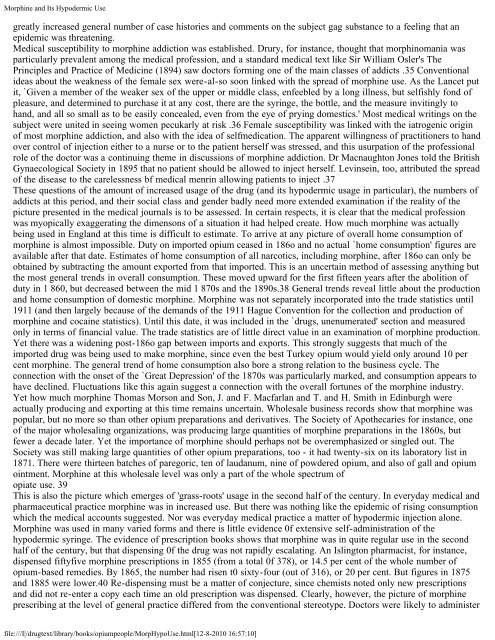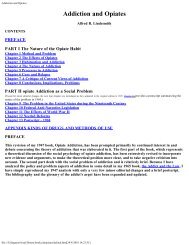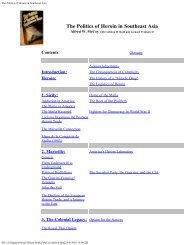opium and the people
opium and the people
opium and the people
Create successful ePaper yourself
Turn your PDF publications into a flip-book with our unique Google optimized e-Paper software.
Morphine <strong>and</strong> Its Hypodermic Use<br />
greatly increased general number of case histories <strong>and</strong> comments on <strong>the</strong> subject gag substance to a feeling that an<br />
epidemic was threatening.<br />
Medical susceptibility to morphine addiction was established. Drury, for instance, thought that morphinomania was<br />
particularly prevalent among <strong>the</strong> medical profession, <strong>and</strong> a st<strong>and</strong>ard medical text like Sir William Osler's The<br />
Principles <strong>and</strong> Practice of Medicine (1894) saw doctors forming one of <strong>the</strong> main classes of addicts .35 Conventional<br />
ideas about <strong>the</strong> weakness of <strong>the</strong> female sex were-al-so soon linked with <strong>the</strong> spread of morphine use. As <strong>the</strong> Lancet put<br />
it, `Given a member of <strong>the</strong> weaker sex of <strong>the</strong> upper or middle class, enfeebled by a long illness, but selfishly fond of<br />
pleasure, <strong>and</strong> determined to purchase it at any cost, <strong>the</strong>re are <strong>the</strong> syringe, <strong>the</strong> bottle, <strong>and</strong> <strong>the</strong> measure invitingly to<br />
h<strong>and</strong>, <strong>and</strong> all so small as to be easily concealed, even from <strong>the</strong> eye of prying domestics.' Most medical writings on <strong>the</strong><br />
subject were united in seeing women pecukarly at risk .36 Female susceptibility was linked with <strong>the</strong> iatrogenic origin<br />
of most morphine addiction, <strong>and</strong> also with <strong>the</strong> idea of selfmedication. The apparent willingness of practitioners to h<strong>and</strong><br />
over control of injection ei<strong>the</strong>r to a nurse or to <strong>the</strong> patient herself was stressed, <strong>and</strong> this usurpation of <strong>the</strong> professional<br />
role of <strong>the</strong> doctor was a continuing <strong>the</strong>me in discussions of morphine addiction. Dr Macnaughton Jones told <strong>the</strong> British<br />
Gynaecological Society in 1895 that no patient should be allowed to inject herself. Levinsein, too, attributed <strong>the</strong> spread<br />
of <strong>the</strong> disease to <strong>the</strong> carelessness bf medical menrin allowing patients to inject .37<br />
These questions of <strong>the</strong> amount of increased usage of <strong>the</strong> drug (<strong>and</strong> its hypodermic usage in particular), <strong>the</strong> numbers of<br />
addicts at this period, <strong>and</strong> <strong>the</strong>ir social class <strong>and</strong> gender badly need more extended examination if <strong>the</strong> reality of <strong>the</strong><br />
picture presented in <strong>the</strong> medical journals is to be assessed. In certain respects, it is clear that <strong>the</strong> medical profession<br />
was myopically exaggerating <strong>the</strong> dimensons of a situation it had helped create. How much morphine was actually<br />
being used in Engl<strong>and</strong> at this time is difficult to estimate. To arrive at any picture of overall home consumption of<br />
morphine is almost impossible. Duty on imported <strong>opium</strong> ceased in 186o <strong>and</strong> no actual `home consumption' figures are<br />
available after that date. Estimates of home consumption of all narcotics, including morphine, after 186o can only be<br />
obtained by subtracting <strong>the</strong> amount exported from that imported. This is an uncertain method of assessing anything but<br />
<strong>the</strong> most general trends in overall consumption. These moved upward for <strong>the</strong> first fifteen years after <strong>the</strong> abolition of<br />
duty in 1 860, but decreased between <strong>the</strong> mid 1 870s <strong>and</strong> <strong>the</strong> 1890s.38 General trends reveal little about <strong>the</strong> production<br />
<strong>and</strong> home consumption of domestic morphine. Morphine was not separately incorporated into <strong>the</strong> trade statistics until<br />
1911 (<strong>and</strong> <strong>the</strong>n largely because of <strong>the</strong> dem<strong>and</strong>s of <strong>the</strong> 1911 Hague Convention for <strong>the</strong> collection <strong>and</strong> production of<br />
morphine <strong>and</strong> cocaine statistics). Until this date, it was included in <strong>the</strong> `drugs, unenumerated' section <strong>and</strong> measured<br />
only in terms of financial value. The trade statistics are of little direct value in an examination of morphine production.<br />
Yet <strong>the</strong>re was a widening post-186o gap between imports <strong>and</strong> exports. This strongly suggests that much of <strong>the</strong><br />
imported drug was being used to make morphine, since even <strong>the</strong> best Turkey <strong>opium</strong> would yield only around 10 per<br />
cent morphine. The general trend of home consumption also bore a strong relation to <strong>the</strong> business cycle. The<br />
connection with <strong>the</strong> onset of <strong>the</strong> `Great Depression' of <strong>the</strong> 1870s was particularly marked, <strong>and</strong> consumption appears to<br />
have declined. Fluctuations like this again suggest a connection with <strong>the</strong> overall fortunes of <strong>the</strong> morphine industry.<br />
Yet how much morphine Thomas Morson <strong>and</strong> Son, J. <strong>and</strong> F. Macfarlan <strong>and</strong> T. <strong>and</strong> H. Smith in Edinburgh were<br />
actually producing <strong>and</strong> exporting at this time remains uncertain. Wholesale business records show that morphine was<br />
popular, but no more so than o<strong>the</strong>r <strong>opium</strong> preparations <strong>and</strong> derivatives. The Society of Apo<strong>the</strong>caries for instance, one<br />
of <strong>the</strong> major wholesaling organizations, was producing large quantities of morphine preparations in <strong>the</strong> 1860s, but<br />
fewer a decade later. Yet <strong>the</strong> importance of morphine should perhaps not be overemphasized or singled out. The<br />
Society was still making large quantities of o<strong>the</strong>r <strong>opium</strong> preparations, too - it had twenty-six on its laboratory list in<br />
1871. There were thirteen batches of paregoric, ten of laudanum, nine of powdered <strong>opium</strong>, <strong>and</strong> also of gall <strong>and</strong> <strong>opium</strong><br />
ointment. Morphine at this wholesale level was only a part of <strong>the</strong> whole spectrum of<br />
opiate use. 39<br />
This is also <strong>the</strong> picture which emerges of 'grass-roots' usage in <strong>the</strong> second half of <strong>the</strong> century. In everyday medical <strong>and</strong><br />
pharmaceutical practice morphine was in increased use. But <strong>the</strong>re was nothing like <strong>the</strong> epidemic of rising consumption<br />
which <strong>the</strong> medical accounts suggested. Nor was everyday medical practice a matter of hypodermic injection alone.<br />
Morphine was used in many varied forms <strong>and</strong> <strong>the</strong>re is little evidence 0f extensive self-administration of <strong>the</strong><br />
hypodermic syringe. The evidence of prescription books shows that morphine was in quite regular use in <strong>the</strong> second<br />
half of <strong>the</strong> century, but that dispensing 0f <strong>the</strong> drug was not rapidly escalating. An Islington pharmacist, for instance,<br />
dispensed fiftyfive morphine prescriptions in 1855 (from a total 0f 378), or 14.5 per cent of <strong>the</strong> whole number of<br />
<strong>opium</strong>-based remedies. By 1865, <strong>the</strong> number had risen t0 sixty-four (out of 316), or 20 per cent. But figures in 1875<br />
<strong>and</strong> 1885 were lower.40 Re-dispensing must be a matter of conjecture, since chemists noted only new prescriptions<br />
<strong>and</strong> did not re-enter a copy each time an old prescription was dispensed. Clearly, however, <strong>the</strong> picture of morphine<br />
prescribing at <strong>the</strong> level of general practice differed from <strong>the</strong> conventional stereotype. Doctors were likely to administer<br />
file:///I|/drugtext/library/books/<strong>opium</strong><strong>people</strong>/MorpHypoUse.html[12-8-2010 16:57:10]





